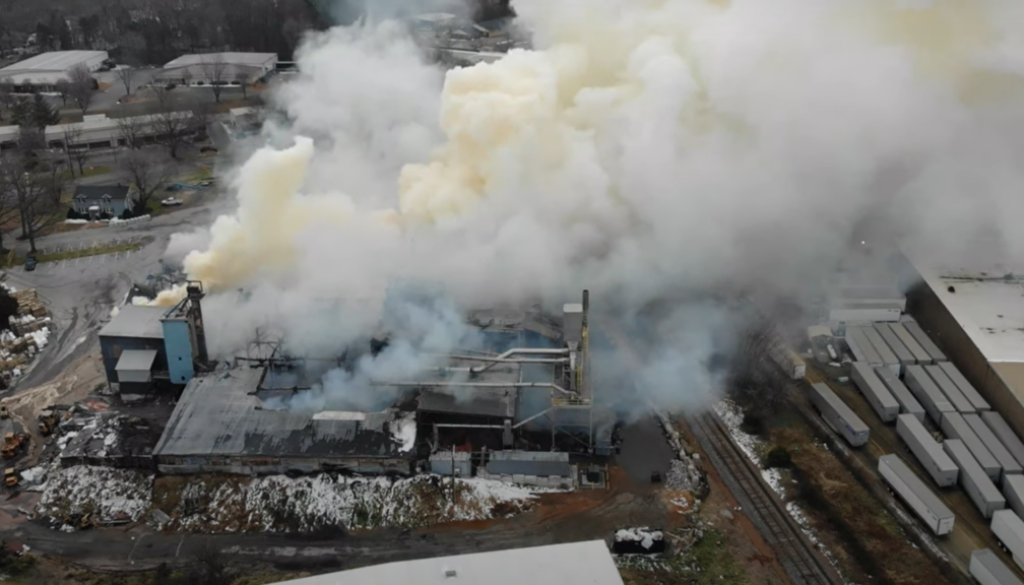A history of deadly chemical facility disasters prompts calls for EPA to help
When the explosions shook her North Carolina home, Jazmine Webster wasted no time racing outside to investigate the series of loud booms that rattled her Winston-Salem neighborhood one late January evening.
The billowing smoke Webster witnessed pointed clearly to the culprit – the Winston Weaver Co., Inc. fertilizer plant a few blocks from her home was on fire. Along with the smoke, Webster could smell something unusual in the air, “definitely a chemical,” she recalled in a recent interview.
Police soon knocked on her door, telling her to evacuate; they were not sure what else might happen at the plant as it burned.
The January 31, 2022, Weaver fertilizer plant fire had so much ammonium nitrate on site that the event could have turned into “one of the worst explosions in U.S. history,” Winston-Salem Fire Chief William Mayo noted when he addressed reporters as the inferno raged.
Explosions of stored ammonium nitrate are responsible for some of the worst chemical disasters on record, according to a joint chemical advisory released in 2015 by the U.S. Environmental Protection Agency, Occupational Safety and Health Administration, and Bureau of Alcohol, Firearms and Tobacco.
In April 2013, an ammonium nitrate explosion at a fertilizer plant in West, Texas, killed 15 people and injured more than 160. In October 2003, in St. Romain en Jarez, France, an ammonium nitrate fire and explosion injured 26 people. In September 2001, a fertilizer facility explosion in Toulouse, France, led to 2,500 injuries and 30 deaths.
Since 1996, the EPA has had in place a Risk Management Plan (RMP) rule that directs companies to report on the quantities of hazardous substances, including ammonium nitrate, that they have on site, along with the potential effects of a chemical accident, and other information.
But after years of calling for stronger regulations to protect the public from the risks posed by fertilizer plants and others facilities where hazardous chemicals are stored, a coalition of faith leaders, environmental advocates and health experts are accelerating their efforts, joining recently with members of Congress to demand the Biden administration enact tighter requirements.
In meetings and communications with top administration officials, the groups say urgent reform is needed.
‘A real and present danger’
Almost 200 million people live near facilities like the Weaver plant, and many work or go to school in areas that would be devastated by worst-case explosions, a coalition of 333 health and environmental experts said in an April 20 letter sent to EPA Administrator Michael Regan, who was North Carolina’s top environmental official before joining the Biden administration in March last year.
“[T]he threat of chemical disasters in the United States is still a real and present danger for many communities and workers across the country,” the letter states. “Chemical disasters, including large-scale releases, fires, explosions, and near-misses, occur regularly across the country, including recently in your home state of North Carolina…”
A group of 31 House and Senate lawmakers wrote their own letter to Regan citing 149 “harmful chemical disasters” per year, on average, over the last ten years.
“Recent chemical disasters have highlighted shortcomings in federal regulations that fail to sufficiently protect workers and communities living near hazardous chemical facilities,” their letter stated.
This month, the nonprofit law group Earthjustice and the New York attorney general’s office also urged new actions.
The groups seeking stricter RMP mandates want the EPA to require companies to use safer chemicals that pose less of a risk in fires; to involve workers in crafting plans for securing chemicals and controlling releases; and to ensure that nearby communities get swift notification about the extent of any incidents, among other measures.
The meetings follow the Biden EPA’s decision to take a retrospective look at its RMP rule, and come after Biden’s 2021 executive order requiring federal agencies to review existing regulations with an eye to tackling the climate crisis and promoting environmental justice. The RMP rule is an equity issue because the regulated facilities are often sited close to low-income or minority communities that historically have faced disproportionately high levels of air, water and other pollution.
‘Too many risks not to tell someone’
Back in Winston-Salem, some residents are pursuing a class action lawsuit against Weaver alleging the explosion and fire resulted in “toxic and/or hazardous chemicals being released into the surrounding community.”
The March 3 filing in Forsyth County Superior Court alleges that the air pollution released during the fire could include plastics, metals and remnants of ammonium nitrate that can irritate the eyes and cause difficulty breathing.
“Defendant’s storage of extremely dangerous and explosive chemicals, including 600 tons of ammonium nitrate, is an inherently dangerous activity,” the lawsuit states.
A representative for Weaver did not respond to a request for comment.
After witnessing the fertilizer facility fire, Webster told The New Lede that she would like the federal government to force companies to tell communities about the chemicals they’re using, and the risks associated with them.
“These chemicals are harmful, there are too many risks not to tell someone,” she said.
 EWG
EWG


